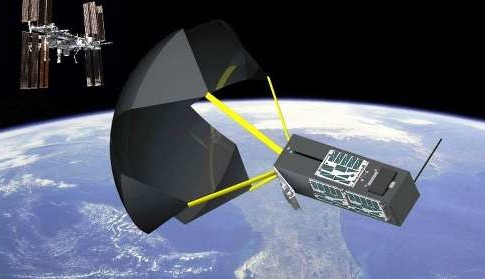XBees In Space
July 17, 2015
on
on

Unless you want it fried to a cinder during re-entry, the only way of returning any item to earth from the ISS is on board a craft along with the astronauts. Following recent tests by NASA, that could all be set to change. They have been experimenting with a novel technique using a small autonomous re-entry vehicle to safely return a payload back to earth. On release from the ISS the first hurdle is to slow the vehicle so that it can begin its descent. Some sort of thruster would do the job but storage of a propellant on board the ISS prior to deployment was considered too risky.
Instead the team of engineers have designed a space parachute (the ExoBrake) which produces enough drag to deorbit the vehicle after a couple of days. Wait a minute, if you’re talking drag, surely you need air and any schoolboy will tell you; in space no one can hear you scream because there isn’t any air in space. Well it turns out the atmosphere just gets more rarefied the further away from earth you travel and at the orbiting height of the ISS the air is extremely rarefied but there are still enough molecules floating around to exert some drag.
The interesting thing about this project from the hacker’s viewpoint is that the team are using standard off-the-shelf development boards like Arduino and XBee to perform all the data collection from the sensors mounted on the experimental re-entry vehicle. An XBee radio network is used instead of hard wiring, to collect sensor data including temperature, air pressure and 3-axis acceleration parameters.
According to Marcus Murbach, the TechEdSat-4 principal investigator at NASA's Ames Research Center in Moffett Field, California "The exo-brake is a self-stabilizing exospheric deorbiting mechanism that will allow us to return a payload to Earth fairly rapidly from an orbital platform, like the International Space Station. We were able to send commands and receive data to and from the satellite via the onboard modem using only a laptop and email account. This capability may greatly benefit the entire nanosatellite community."
XBee is a brand name of Digi International.
Instead the team of engineers have designed a space parachute (the ExoBrake) which produces enough drag to deorbit the vehicle after a couple of days. Wait a minute, if you’re talking drag, surely you need air and any schoolboy will tell you; in space no one can hear you scream because there isn’t any air in space. Well it turns out the atmosphere just gets more rarefied the further away from earth you travel and at the orbiting height of the ISS the air is extremely rarefied but there are still enough molecules floating around to exert some drag.
The interesting thing about this project from the hacker’s viewpoint is that the team are using standard off-the-shelf development boards like Arduino and XBee to perform all the data collection from the sensors mounted on the experimental re-entry vehicle. An XBee radio network is used instead of hard wiring, to collect sensor data including temperature, air pressure and 3-axis acceleration parameters.
According to Marcus Murbach, the TechEdSat-4 principal investigator at NASA's Ames Research Center in Moffett Field, California "The exo-brake is a self-stabilizing exospheric deorbiting mechanism that will allow us to return a payload to Earth fairly rapidly from an orbital platform, like the International Space Station. We were able to send commands and receive data to and from the satellite via the onboard modem using only a laptop and email account. This capability may greatly benefit the entire nanosatellite community."
XBee is a brand name of Digi International.
Read full article
Hide full article



Discussion (2 comments)
John Hind 9 years ago
Bill Graham 9 years ago